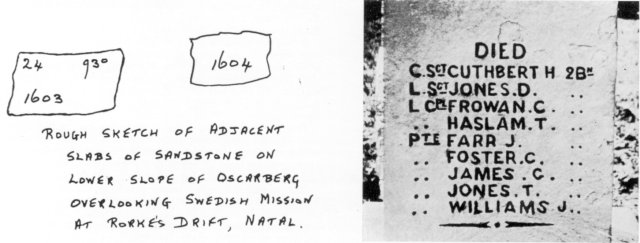

 The South African
The South African
Notes, Questions and Replies
One of the slabs had the figure “24” cut out in the left-hand top corner and the figure “93” in the top right-hand corner. Underneath was cut, also by a relatively unskilled hand, the figure “1603”, whilst on a nearby rock was carved the figure “1604”
Photograph by Grant Menzies
Monument at Rorke’s Drift showing name of Pte C. James of the 2nd Battalion, 24th Regiment

Monument at Rorke's Drift showing name
of Private G. James of the 2nd Battalion, 24th Regiment
Photograph by Grant Menzies
Being intrigued by these engravings, I came to the conclusion that the “24” referred obviously to the 24th Regiment, but that the “93” could not refer to the 93rd Regiment (the 2nd Battalion of the Argyll and Sutherland Highlanders), as that regiment did not take part in the Zulu War. This figure was, therefore, meant to be “930” or “938”, probably the latter, on the basis that the lower part of the “8” had either not been completed or had worn away. The other two numbers seemed to me to be regimental numbers of two men, probably pals, who joined the 24th Regiment at the same time. This all seemed to tie in with the idea that the engravings, which were similar to others that I have found in the Transvaal, were done by men on outpost duty during the day when they had much time on their hands and nothing to do but keep a watch on the surrounding countryside and the drift over the Buffalo River near Fort Melvill, which was built after the fateful night at Rorke’s Drift of 22nd January, 1879.
A diligent search through the medal roll of the 1St Bn 24th Regiment proved fruitless, as I had expected, but a search through the roll of the 2nd Battalion of the 24th Regiment revealed the following information:
No 1603 Pte W. Holloway
No 1604 Pte G. James — died of disease 23/2/1879
No 930 Pte P. Murphy
No 938 Pte W. H. Smith
All these men served in the Zulu War, while Pte Smith and Pte Murphy also served in the 1877-78 campaigns.
The death of Pte G. James is recorded in the “Historical Records of the 24th Regiment” by Paton, Glennie and Symons as having taken place after Rorke’s Drift, but there is no mention of where he is buried. It is often assumed that, apart from the marked grave of a soldier drowned later in the Buffalo River, the Swedish Mission cemetery contains only the graves of the men who died whilst engaged in the heroic defence of Rorke’s Drift on 22nd January, 1879, but contemporary reports and also the records of the War Graves’ Board disclose that there are 29 men buried in the cemetery. Amongst this number is Private G. James, No 1604, 24th Regiment, and the accompanying photograph of one side of the monument in the cemetery clearly shows his name.
H. W. Kinsey
23. Carbutt's Border Rangers. This unit does not appear in Tylden's "Armed Forces of South Africa".
Raising was authorised by Govt Notice 100 of 15/3/1879 (Natal Govt Gazette of 18/3/1879) for local defence of Klip River County.
Officers appointed were:
| Capt. T.M. Carbutt | 3rd January, 1879 |
| Lt A. Busk | 14th January, 1879 |
| J.M., T.W. Birchmore | 14th January, 1879 |
| M.O., F.W. Hyde | 3rd January, 1879 |
The unit was placed under the command of the Colonial Commandant of District No 1.
Strength was 36 Europeans and 35 Native Scouts. (N.G.G. 25/11/1879 Summary of Colonial Forces raised by the Natal Govt during the Zulu War, 1879).
The Corps is referred to by H. P. Holt, “The Mounted Police of Natal” (p. 75-76), as Carbutt’s Horse and was, at one time, in garrison at a farm in the Wasbank area, where it was living on dampers and rum, and enjoying the name of the Blind Owls. Date of disbandment has not yet been traced.
Capt Carbutt’s S.A.G.S.M. without bar is in the Ladysmith Museum, incorrectly labelled as having been awarded for service in the Anglo-Boer War.
J. J. Hulme
24. In Volume 1, No 2 (June, 1968), of the Military History Journal, Mr Arthur Blake treated us to some World War I exploits of Capt Ian Vernon Jeffrey Pyott, DSO. This distinguished South African died in his sleep after a long illness on 23 July, 1972 at the age of 76. The son of the late Mr John Pyott, founder of Pyott Ltd., he was born in Dundee, Scotland, in 1895 and came to South Africa with his parents the same year. After completing his education in Edinburgh, he returned to South Africa and began training as a miller. He then served in the war and afterwards started the Durban factory of Pyott (Natal) Ltd. In 1946 he settled in Port Elizabeth where he stayed until his death.
B. G. Simpkins
Return to Journal Index OR Society's Home page
South African Military History Society / scribe@samilitaryhistory.org